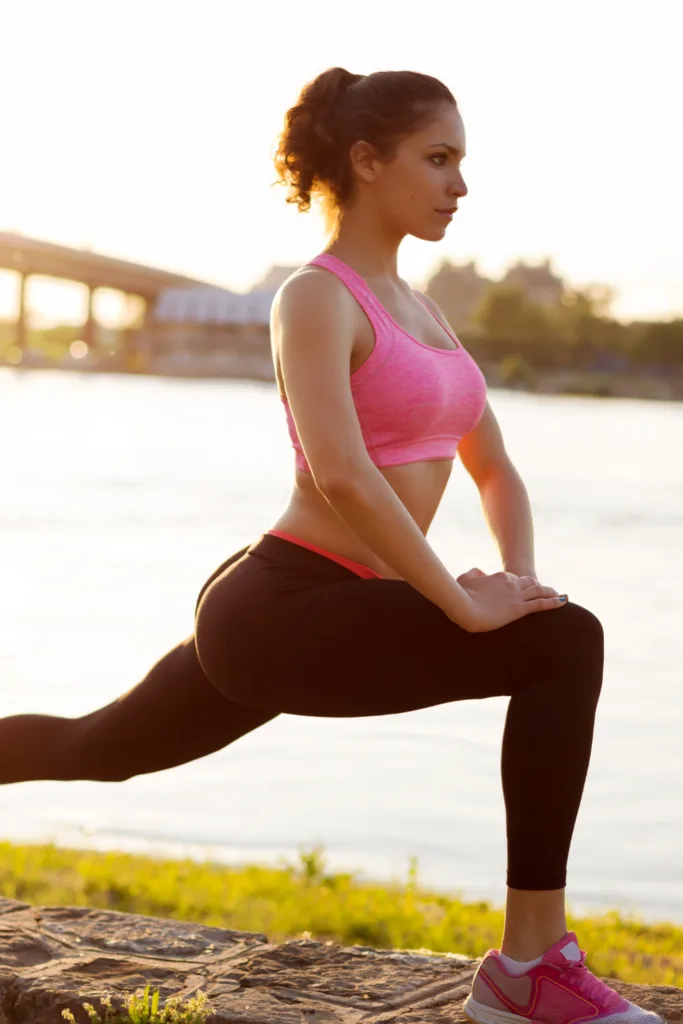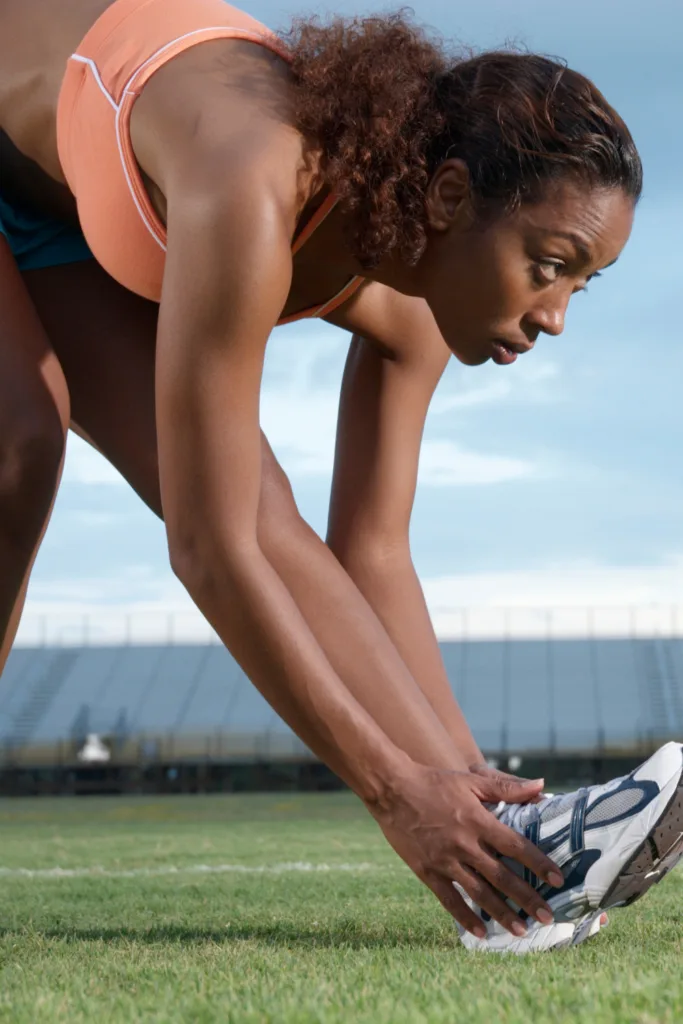Every runner knows the importance of stretching after a run as part of a cool down, but what about the warm up?
Pre-run stretches are essential to get your body and mind ready for the run ahead.
Not only do they reduce the risk of injury, they reduce muscle stiffness and optimise your performance.
But what are the best stretches to do before running, and how should they be performed?
In this guide we’ll look at:
- Pre-run stretches: What type of stretching should you do before a run?
- Benefits of dynamic stretching
- How to warm up before a run
- The 9 best pre-run stretches to do before a run (and how to do them properly)
Ready?
Let’s go!

Pre-run stretches: What type of stretching should you do before a run?
While the benefits of stretching are well known, controversy still remains about the best type of stretching that should be performed before a run.
There are two main types of stretching that are frequently examined in the running and fitness community.
These are:
- Static stretching
- Dynamic stretching
Arguably, the type of stretching that people are most familiar with is static stretching.
This is when a position is held with the muscle on tension to a point of stretching and then repeated.
Static stretching can be performed actively by yourself, or passively with a partner, but is not recommended as part of a warm up.
This is because static stretching done immediately prior to exercise has been shown to have detrimental effects on muscle strength and performance in activities like running and jumping.
In fact, the loss of strength resulting from static stretching has been termed ‘stretch-induced strength loss’.
The causes of this strength loss are not well understood, but some suggest mechanical factors are at play.
Static stretching is most beneficial for athletes requiring flexibility for their sports (e.g. gymnastics, dance etc).
Dynamic stretching, on the other hand, involves moving a limb through its entire range of motion and repeating several times.
This type of stretching (also known as active stretching) is recommended as part of a warm up before a run because it has been shown to improve power and running performance.
Therefore it is better suited for athletes requiring running or jumping performance, such as runners and basketball players.
Related: 7 of the best glute strength exercises for runners

Related: 3 easy ways to boost your running form and technique
Benefits of dynamic stretching
A 2019 study found that, when performed before exercise, dynamic stretching helps to:
- Increase range of motion
- Helps avoid muscle injuries
- Increases joint flexibility
- Reduces stiffness
- Optimises performance
Dynamic stretching increases blood flow to the muscles, elevates your heart rate and increases your body temperature, which are all important when it comes to running.
Think about it: starting your run without doing a proper warm up will make the first mile so much harder.
Before your run, your body is in a fairly restful state.
Your blood oxygen levels are low making it difficult to fuel the high level of activity needed for running.
By doing dynamic stretches as part of a warm up, your body will start to ramp up its oxygen levels to accommodate the higher demand and will start to enter an aerobic state.
Once your body gets here, it will have the oxygen it needs to perform at a high level during your run.
It often takes 10 minutes or so for your oxygen levels to ramp up, so even more reason to do a warm up to ensure your body is ready to go at the start of your run.
Related: 7 essential running form drills for beginners to improve speed and endurance

How to warm up before a run
Now you know the benefits of dynamic stretching, here are a few sample warm up routines to try before your next run.
The length and intensity of your run will determine the best type of warm up routine for you.
Warm up routine 1: Best for shorter, harder efforts at a challenging pace
- Light jogging (10 minutes)
- Dynamic stretches (10 minutes)
- 60m strides with a jog back recovery (5 minutes)
Warm up routine 2 – Best for longer, easier efforts at an easy pace
- Light jogging (10-15 minutes)
- Dynamic stretching (5 minutes)
The dynamic stretches you choose to include in your warm up routine should mimic the sport or type of exercise that you will be doing.
In this case, if you’re heading out for a run, the dynamic stretches should imitate the motions that will be made during your run and target the muscles that will be used.
Running is an ‘all body’ movement, so the stretches will need to target all the main muscle groups.
At the end of this guide, you will find a list of the best pre-run stretches to do before a run with instructions on how to do them properly.
Related: 5 dynamic hip flexor stretches for runners + how to do them

The 9 best pre-run stretches (and how to do them properly)
#1 Leg swings
Leg swings can be done forwards and backwards or side-to-side whilst you face a wall.
They are one of my favourite dynamic stretches for runners because they mobilise your legs, while also working your hip flexors, abductors and adductors.
The leg swing should be a controlled movement with no forced effort.
- Stand with your feet hip width apart and start to swing one leg back and forth while balancing on the other. Hold onto a wall or tree if needed.
- Swing your leg forward and backward 5-10 times.
- Bring your leg down and repeat with the other leg, swinging 5-10 times.
#2 Hamstring sweeps
Hamstring sweeps are great for mobilising your hamstrings which are the key muscles at the back of your upper leg.
Your hamstrings can often feel tight so it’s important to maintain flexibility and mobility to reduce the risk of injury.
- Take a short step forward keeping your heel firmly on the ground.
- Keep your front leg straight and bend your back knee, sinking your bottom towards the ground as though you’re about to sit in a chair.
- At the same time as keeping the front leg straight, sweep down with your hands towards the ground.
- Alternate legs as you walk forwards – each movement should take two to three seconds on each leg.
#3 Deep forward lunge
This is another one of my favourite dynamic stretches for runners as it targets your glutes and hip flexors which can easily become tight and sore when you run regularly.
- Start by standing with your feet together then step your right leg forward and lower down.
- Bend both your knees to a 90 degree angle – your back knee should come close, but never touch the ground.
- Reach towards the ground with your left arm and bring your torso forward over your front leg.
- Hold for three seconds then return by pushing through your right heel and return standing.
- Repeat on the opposite leg. Do 5 reps on each leg.
#4 High skips
High skips are so satisfying to do as part of a warm up.
They are an all-body movement which means they target your legs, arms, shoulders and core.
It’s advisable to do high skips at the end of a warm routine as they can be quite demanding physically.
- Start out by skipping and drive your knee up, whilst remaining in control of the movement (i.e. not flapping your arms).
- Aim to go as far and high on each stride as possible.
- Do them for 15-20 seconds then repeat.

#5 Side shuffles
Side shuffles are great for raising your heart rate, making them one of the best dynamic stretches for runners.
They also target all the key running muscles: calves, hamstrings, glutes and quads. You’ll also find they’ll test your agility and coordination.
- Start by standing with legs straight and arms hanging by your sides.
- Step to the side by doing quick side shuffles.
- Shuffle for 10 to 15 metres then repeat on the other side.
- Keep doing them for about one minute.
#6 Fast feet
This dynamic exercise is great for raising your heart rate before a run, as such I normally do this at the end of a warm up as a finisher.
You will feel the burn in your glutes and quads after this dynamic warm up.
- Start with your feet hip-width apart.
- Sink your bottom towards the ground into a half squat position and reach your arms out in front of you,
- Lift your heels up so you are on the balls of your feet.
- Start running as fast as you can on the spot.
- Stay low as you run.
- Aim to run on the spot for 15-30 seconds.
#7 Arm circles
Arm circles are probably one of the simplest dynamic stretches for runners to do before a run, and yet so beneficial.
They get your arms and shoulders mobilised for your run, which is important as your shoulders can become tight if you’re someone who sits behind a desk all day.
- Stand with your feet shoulder-width apart, arms by your sides.
- Slowly swing your arms forward in a circular motion. You should feel your shoulders loosening up as you do this.
- Continue in a circular motion, then circle the arms in the opposite direction.
- Do 8 reps each direction.
#8 Lateral arm swings
Another great movement to target your chest, arms and shoulders is lateral arm swings.
They are also great for releasing tension in your upper body.
- Stand tall with your feet hip width apart.
- Put both arms straight out in front of you then using your hips and core twist right and left – your outer arm should fold across your chest.
- Keep your arms outstretched and parallel to the ground throughout, but loose and flexible enough at the same time.
- One full rotation is one rep. Do 15-20 reps.
#9 Star touches
Star touches are great to mobilise your arms and shoulders before a run.
- Stand with your feet wider than shoulder-width apart.
- While keeping your legs as straight as possible, reach across your body with your right hand and touch the toes of your left foot.
- Straighten back up to the starting position and repeat on the right side.
Related: Walking 2 miles a day: 12 benefits + how to start
- 5 things I wish I’d known before returning to running - March 3, 2024
- Running 20 minutes a day: Benefits + how to start - January 27, 2024
- How to run your first 2 hour half marathon - January 16, 2024
